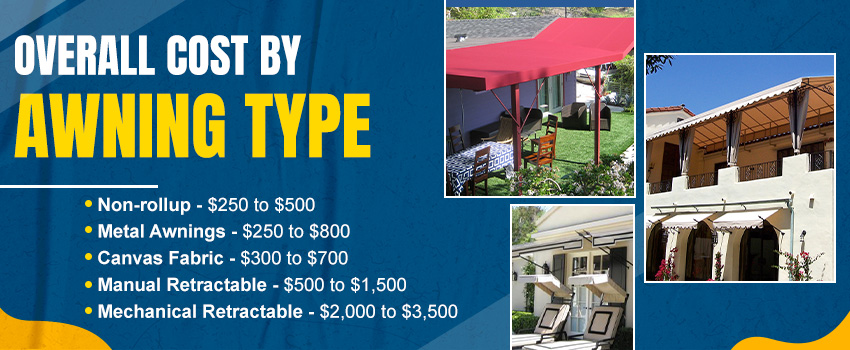Awnings are ideal for homeowners as they offer many advantages, ranging from energy savings to shelter. They are installed over windows, doors, and patios, and installing them can provide additional outdoor space to embrace quality time.
The installation is not critical, especially when pro-grade service providers are involved. Experts get the work done in less time while suggesting the best options. However, hiring a professional installer will add anywhere between $100 and $400 to your overall cost.
Installing an awning can cost you approximately $2,500. The canopy costs $250–$3,500. Homeowners may spend somewhere between $1,200 and $3,600 after the installation. Below, we will break down the average installation costs.
Average Costs for Awning Installation
Apart from the product cost, installation expenses fall between $175 and $450 ($6–$9 per square foot). It includes hiring installers and electricians (for motor-operated awnings).
However, the price may change depending on the material selected, the building’s condition, and the total area. The time taken to install is about an hour, which can extend up to five hours when installing a retractable awning.
Deck – Window – Patio
Window and door awnings do not cost much as they are usually not retractable. They can cost approximately $100 (minimum) to $400 (maximum).
But awnings for decks and patios can be expensive and rise from $600 up to $3,500 or a little more. Homeowners can choose the product to be free-standing or attached to the house.
Accessories for Awnings
Homeowners inclined towards luxury often choose a few accessories to complement their newly installed awning. One such accessory is curtains, which adds another $100–$200 to the overall cost. Likewise, adding mosquito nets may cost $100–$250.
If you are not restricted by budget, spend anywhere from $8,500 and $23,000 to enclose the patio space. It might seem expensive, but it is also a one-time investment.
Pro tip: save the extra expense by installing accessories during installation.
Overall Cost by Awning Type

Homeowners will find different awning types to choose from, such as metal, manual retractable, non-rollup, and canvas, to name a few. Each costs differently because of its unique features and installation procedures. Let’s look at a few.
Metal Awnings
These are available between $250 and $800. Metal awnings are robust compared to other awning types. But they have a drawback, which is less visibility. Metal awnings are usually aluminum-made and are a good choice for patios and doors.
Manual Retractable
It will cost about $500 to $1,500. The slightly higher cost is due to its retractable feature. You can fold it whenever you want, which makes it perfect for patios as they are most susceptible to weather conditions.
Mechanical Retractable
Unlike manual retractables, the mechanical version retracts automatically. You may have already guessed; it is the most expensive awning variant. Expect to spend somewhere between $2,000–$3,500.
It is available in canvas and metal variants. So, homeowners living in areas with frequently changing weather conditions will enjoy this awning.
Non-rollup
Non-rollup awnings cost significantly lesser (between $250 and $500). It can be canvas or metal-made, so you choose what you prefer. While these awnings are affordable, they are not very flexible. Hence, you cannot pull them back during harsh weather conditions.
Canvas Fabric
It is another affordable option for homeowners. Canvas awnings are available for $300–$700. They are among the most common choices because of their low cost and durability.
The biggest advantage of canvas awnings is that they are versatile and offer plenty of customization options, from colors and patterns to sizes and shapes, which makes them attractive. They are best suited for windows and small patios.
Final Words
We hope you now have a detailed understanding of awning installation and the costs associated with installing different types of awnings. If you have decided what you want, you can kickstart your project by contacting a reliable service provider. Alternatively, you can consult them for guidance on material and feature selection.

